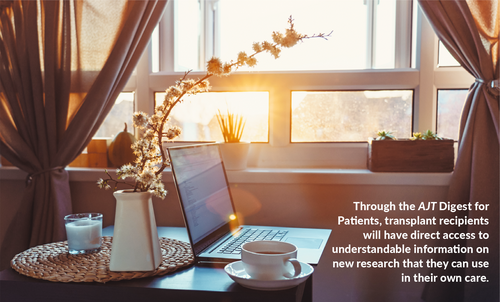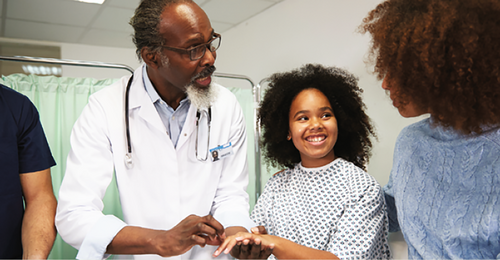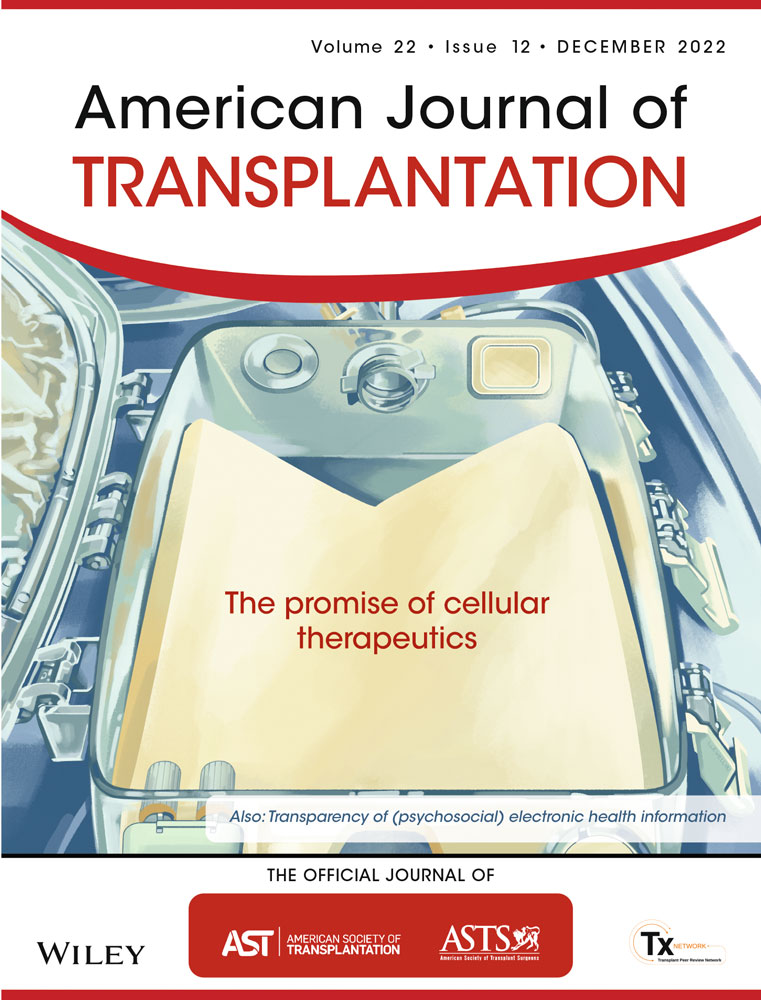AJT Digest for Patients: Their Own Window into Key Research
Abstract
In this month's installment of “The AJT Report,” we announce the launch of The AJT Digest for Patients, our new source of research information curated and designed specifically for transplant recipients. We also report on positive news concerning the use of living unrelated donor kidneys for pediatric kidney transplants.
A new information source from the American Journal of Transplantation aims to educate and enlighten transplant recipients, and help clinicians to do the same
Key Points
- The American Journal of Transplantation is reaching out to transplant patients twice yearly with The AJT Digest for Patients.
- The Digest aims to highlight for transplant recipients how research scientists are working hard to advance the field and improve patient quality of life.
- The new information source will include a lay summary of the research drafted by a study author and edited by a transplant recipient, intended to provide transplant recipients with a window into the breadth of research in transplantation.
- Clinical teams can use the Digest as a tool to bridge the gap between research information and the patients who both want and need it.
The American Journal of Transplantation (AJT) has launched a new biannual online publication, AJT Digest for Patients, that will feature summaries of five select, patient-focused articles that have appeared in AJT within the last 6 months to 1 year. The Digest will be distributed through patient organizations around the world, such as the American Association of Kidney Patients and Transplant Recipients International Organization, via a linked logo. That link will then be shared with patients via email or newsletters. Each article writeup will include the title, the authors, a 200-word lay summary drafted by the lead study author, the visual abstract, and first and senior author photos. There will also be links to the paper itself and to AJT Highlights, the monthly podcast, where those same articles will be discussed.
- Xenotransplantation
- Replacing the trachea
- Food safety
- Flu vaccination
- Air pollution
A Personal Perspective
Each Digest lay summary is edited by Amy Silverstein, a novelist and attorney who has lived with a transplanted heart for 34 years. “I feel very strongly that the Digest is important and will make a difference,” Ms. Silverstein says. For her, the research is personal, and she believes the information will bring patients messages of hope and of ever-increasing excellence of care.
Today, Ms. Silverstein celebrates life with gratitude, but she also knows from experience that it is all too easy for a transplant patient to lose hope over time. When such patients see their transplant peers getting sick and dying, it can be difficult to remain optimistic. “Sadly, everyone I know who had a heart transplant around the time I did is long gone,” Ms. Silverstein reflects. She finds hope, however, in learning that transplant scientists are working hard to solve the myriad of issues she faces every day and that have felled her fellow transplant recipients.
As a recipient of two heart transplants from two different centers, Ms. Silverstein has learned that protocols and follow-up care vary not only over time, but also across centers. She notes, for example, that heart biopsies are still routine in some centers and not in others. However, she learned from reading AJT that at 6 months post heart transplant, such biopsies lose their utility.1 “Many patients have a narrow view that transplant medicine is what they are receiving at their transplant center,” explains Ms. Silverstein, noting that most patients do not understand that approaches to care can vary from center to center. The Digest will provide patients with a window into global best transplant practices that patients can use to observe the emergence of the best possible standards of care.
Ms. Silverstein also notes that fatigue can set in as patients endure the side effects of immunosuppression and struggle to maintain their transplants. She believes that seeing the latest research findings will inspire patients to continue the fight. “If you see that doctors are seeking excellence in patient care, then maybe you will seek personal excellence in taking care of your transplant health,” says Ms. Silverstein.
Patient-Centered Experience
Mara McAdams DeMarco, PhD, a member of the faculty of the Departments of Surgery and Population Health at NYU Grossman School of Medicine, wrote one of the inaugural lay summaries to appear in the Digest. Her research highlights the presence of fine particulate matter (PM2.5) in air pollution and the fact that it could be a health threat to kidney recipients.
“This is such an amazing step forward for the field,” she says. “I was excited to hear that AJT was launching this, and I was honored to [author]…one of the first papers selected.” She sees the Digest as a tool that the clinical team can use to bridge the gap between research and patients.
While Dr. McAdams DeMarco's Digest summary includes a recommendation that patients consider wearing masks or avoiding outdoor activities on days with poor air quality, she says that the most important implications of her findings manifest on a national policy level. She hopes that the transplant community takes from her work an understanding that there is still room to create better policies to improve air quality to such a level that it is protective of vulnerable populations such as transplant recipients. Dr. McAdams DeMarco sees her air quality paper as part of the overarching theme of her research on the importance of the patient story. “There's so much emerging research that is going to move the field forward,” she points out, and adds that her research efforts center on patients’ “daily struggles and how can we [ameliorate] them.”
“I believe that the Digest is something that should be read by everyone,” says Dr. McAdams DeMarco, and she explains how the lay summaries will help give support to staff, nephrologists and surgeons by providing context to the daily lives and lived experience of patients. She feels the Digest should also provide an opportunity for the transplant community to reflect on the research and what it means for patients. “Producing research for the sake of publishing is a failure in the system,” says Dr. McAdams DeMarco. “The Digest's lay summaries [will] move towards improving research dissemination.”
Even though the transplant community expends a great deal of effort in educating patients, Dr. McAdams DeMarco believes that the patient community still suffers from limited health literacy. She recognizes that physicians do not always have the time to read through a paper and find the language necessary to communicate the results to patients during quick patient encounters. She anticipates that the lay summaries will provide the language that clinicians need to create a patient-centered experience and communicate science to patients.
Looking Forward
Sandy Feng, MD, PhD, editor-in-chief of AJT, expects that the Digest will continue to evolve and that AJT will solicit patient input, perhaps through focus groups. The current batch of research articles includes breakthrough discoveries (xenotransplant and trachea transplant), actionable articles (vaccination and food safety) and policy questions (air pollution). By seeking feedback, Dr. Feng and Ms. Silverstein will try to determine the precise mix of issues that patients want to know about, as well as the level of summary detail that best meets patient needs. Lastly, they want to know where and how patients would most like to receive the information. There are many options: on paper, online, in podcasts, in waiting rooms, during the screening process and during physician encounters, to name a few.
Looking forward, Dr. McAdams DeMarco feels that the Digest will help to increase patient participation in research. Providing this accessible source of information can help patients understand the process of research, the need for funding and the role that patients play in enabling research. She emphasizes that in her work, every transplant patient advances the understanding of transplant medicine, and she hopes that the Digest will help to bring that message to transplant recipients.
Ms. Silverstein has noticed that many transplant patients rest in gratitude for their gift but do not necessarily look forward to see how they may play a role in advancing the shared mission of research. The Digest aims to help to close that gap between thought and action. Ultimately, however, the organ recipient's thoughts return to what she believes could be the most important role of the Digest: shining a positive light into the future. “Hope is powerful medicine,” she says.
Reference
Living Unrelated Donors are a Good Option for Pediatric Kidney Transplant
Transplant centers may have the option of transplanting pediatric patients with living unrelated donor (LURD) kidneys, living related donor (LRD) kidneys and deceased donor (DD) kidneys. However, some transplant centers are reluctant to transplant LURD kidneys because of conflicting data on long-term outcomes of pediatric LURD renal transplants compared with transplants of kidneys from other donor sources. Now, a new study has revealed that pediatric LURD kidney recipients have comparable graft survival to that of LRD kidney recipients and that pediatric DD kidney recipients have the poorest graft survival. The study is the largest to date comparing the long-term outcome of pediatric kidney transplantation from different transplant sources and indicates that centers should embrace noncommercial living unrelated transplantation as a viable option for children.
Authors 1reviewed data from the Organ Procurement and Transplantation Network database dated January 1, 2001, to September 30, 2021, and compared rates of graft failure and death as well as long-term outcomes for 12 089 children who received one of the three categories of organs during this 20-year period. The investigators hypothesize that the better outcomes for LURD and LRD kidney transplants are because living organ donation allows for better matching and management of the procured organ than does deceased organ donation.






